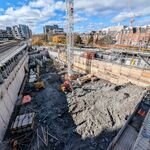M II A II R II K
Senior Member
Misunderstanding Historic Preservation
Mar 17th, 2011
By Johanna Hoffman

Read More: http://americancity.org/buzz/entry/2936/
Of all the design disciplines, historic preservation is perhaps the most misunderstood. While it’s widely accepted that architects design our buildings, and planners organize our cities, the role of preservationists merits less appreciation. Popular culture abounds with clichés of the preservation zealot – there’s the gray-haired old lady laying herself down in front of an oncoming bulldozer, the guy dedicated to rescuing decrepit buildings and saving historical artifacts, and the Not-In-My-Back-Yard types preventing economic development at every turn.
But perhaps we’ve been too hard on historic preservation. While those stereotypes do exist, many working in the profession today imbue the preservation process with flexibility and economic vitality. “I hate that ‘preservationist’ label,†says Randall Mason, Chair of PennDesign’s Historic Preservation program, “because it suggests that you’re an ideologue, that a preservationist is always going to say ‘don’t tear it down.’†The real issue preservation professionals deal with, he explains, is the difficulty of how to manage change.
As we move farther into the 21st century, that issue is only growing more important. Rising human populations, diminishing natural resources, and an uncertain energy future call for new development strategies, widely referred to today as ‘smart growth.’ According to a recent piece by Donovan Rykema, a nationally known consultant on historic preservation economics, it turns out that smart growth’s biggest ally is – you guessed it – historic preservation.
Rykema’s reasons are many. Most importantly, he emphasizes, is the fact that historic preservation is an avenue for examining and valuing our existing assets. Why invest money to tear down and reconstruct what’s already there? Historic buildings by and large have water lines, gutters, and streets already in place. Older ones, designed before cars were the dominant mode of transportation, instill surroundings with strong pedestrian orientations. If our future is aimed at reducing our reliance on automobiles, using buildings planned for human access is the smart place to start.
.....

Mar 17th, 2011
By Johanna Hoffman

Read More: http://americancity.org/buzz/entry/2936/
Of all the design disciplines, historic preservation is perhaps the most misunderstood. While it’s widely accepted that architects design our buildings, and planners organize our cities, the role of preservationists merits less appreciation. Popular culture abounds with clichés of the preservation zealot – there’s the gray-haired old lady laying herself down in front of an oncoming bulldozer, the guy dedicated to rescuing decrepit buildings and saving historical artifacts, and the Not-In-My-Back-Yard types preventing economic development at every turn.
But perhaps we’ve been too hard on historic preservation. While those stereotypes do exist, many working in the profession today imbue the preservation process with flexibility and economic vitality. “I hate that ‘preservationist’ label,†says Randall Mason, Chair of PennDesign’s Historic Preservation program, “because it suggests that you’re an ideologue, that a preservationist is always going to say ‘don’t tear it down.’†The real issue preservation professionals deal with, he explains, is the difficulty of how to manage change.
As we move farther into the 21st century, that issue is only growing more important. Rising human populations, diminishing natural resources, and an uncertain energy future call for new development strategies, widely referred to today as ‘smart growth.’ According to a recent piece by Donovan Rykema, a nationally known consultant on historic preservation economics, it turns out that smart growth’s biggest ally is – you guessed it – historic preservation.
Rykema’s reasons are many. Most importantly, he emphasizes, is the fact that historic preservation is an avenue for examining and valuing our existing assets. Why invest money to tear down and reconstruct what’s already there? Historic buildings by and large have water lines, gutters, and streets already in place. Older ones, designed before cars were the dominant mode of transportation, instill surroundings with strong pedestrian orientations. If our future is aimed at reducing our reliance on automobiles, using buildings planned for human access is the smart place to start.
.....





